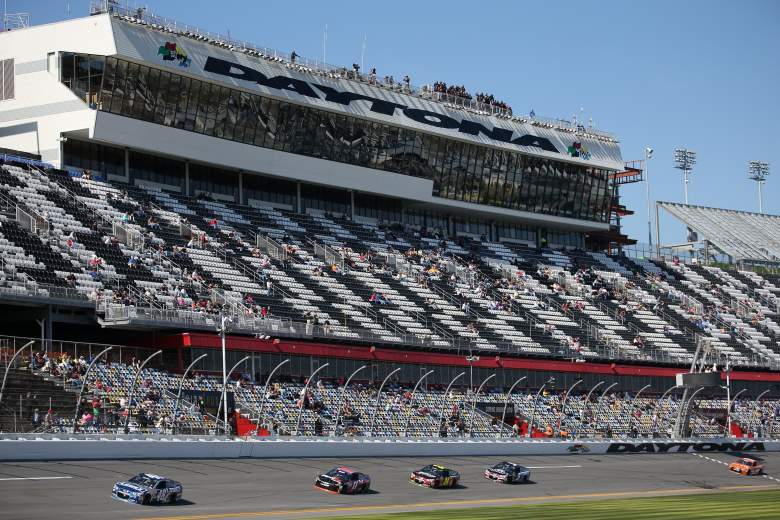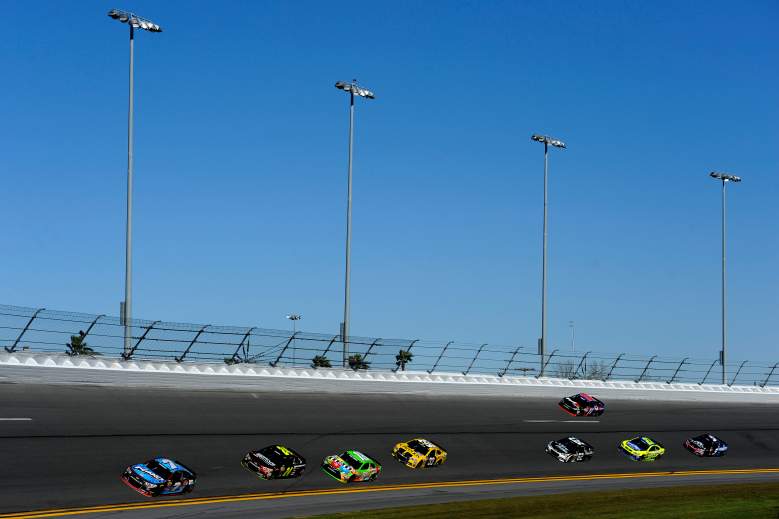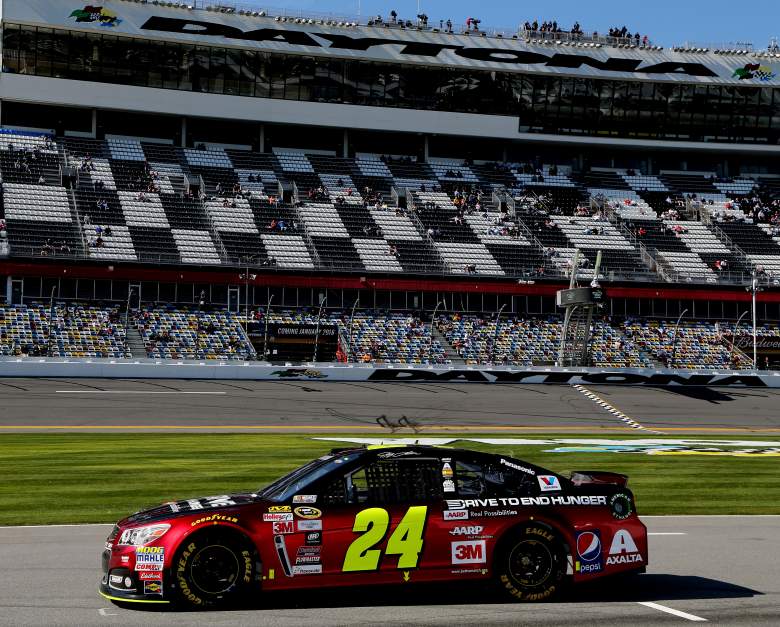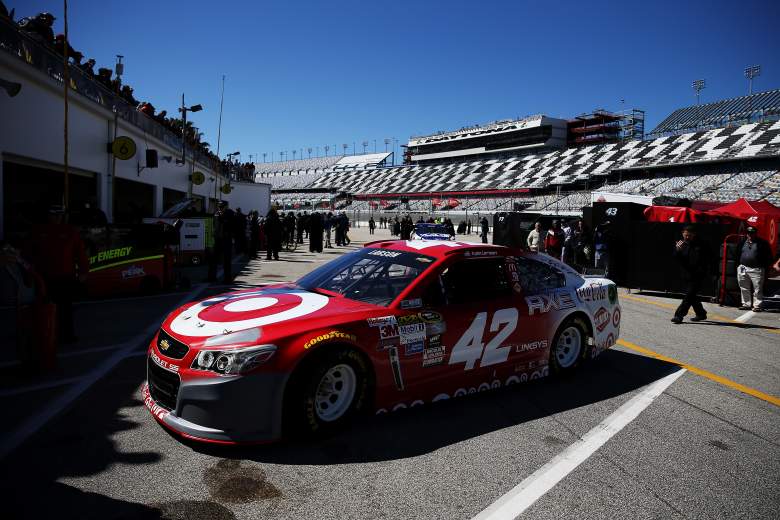
Daytona International Speedway (Getty)
The Daytona International Speedway is located in Daytona Beach, Florida and is home to the biggest race on the NASCAR calendar, and the biggest race in the world, the Daytona 500.
According to the track’s official website:
Though the season-opening NASCAR Sprint Cup event garners most of the attention – as well as the largest audience in motorsports – the enormous 480-acre motorsports complex boasts the most diverse schedule of racing on the globe, thus earning it the title of “World Center of Racing.”
The Daytona 500 is this Sunday, February 22nd. The track’s Twitter is a good source for live updates.
1. The Track Turns 57 Years Old in 2015

Pit road during Daytona 500 Qualifying. (Getty)
The track is one of the oldest in the United States, but has also gone through several upgrades throughout the years, which has kept it looking as young as ever. The track first officially opened in 1959:
This track opened in 1959, when Bill France Sr. made the bold call to build a superspeedway six miles from the beach and hard by the local airport. It features some unique characteristics, including high-banked turns and a lake in the middle, but this is mostly about what’s transpired here.
It is, along with Indianapolis Motor Speedway, one of the nation’s two most significant tracks. Indy seats more, though, and is much more iconic, what with that front stretch that runs through a canyon of stands.
The Indianapolis Speedway is home to the Indianapolis 500, the IndyCar Series’ biggest race and the Brickyard 400, one of NASCAR’s other biggest races.
2. The Daytona International Speedway Is 1 of the Largest Outdoor Stadiums in the United States

(Getty)
Daytona International Speedway is the largest outdoor stadium in Florida, and is one of the largest in the United States. The entire complex is 480 acres.
Here are the track’s dimension and measurements, which can also be found on Daytona International Speedway’s website:
Track :
2.5-mile trioval superspeedway
40 feet wide with 12- to 30-foot apron
Turns:
Banking: 31 degrees
Length: 3,000 feet
Radius: 1,000 feet
Trioval
Banking: 18 degrees (at start/finish line)
Frontstretch:
Chute length: 1,900 feet (from turn to middle of trioval)
Total length: 3,800 feet
Banking: Minimal for drainage only
Backstretch:
Length: 3,000 feet
Banking: Minimal for drainage only
Pit Road:
Length: 1,600 feet
Width: 60 feet
Garage Area:
Sprint Cup Garages: space for 74 cars
Nationwide Series Garages: space for 74 cars
Alternate garage pad: spaces for 54 18-wheelers
Road Course:
3.56 miles for sports cars, 3.51 miles for motorcycles and 2.9 miles for motorcycles (incorporates trioval superspeedway and non-banked infield section) Infield course and chicane range from 30 to 50 feet wide
Speedway Facility:
Total acreage: 480 acres
Infield: 180 acres (includes 29-acre Lake Lloyd)
3. The Track Has Accumulated a Lot of History

Jeff Gordon’s No. 24 car (Getty)
The Daytona International Speedway is also one of the oldest road tracks in the United States. The Daytona 500 has accumulated a lot of history.
On Thursday, the Orlando Sentinel listed Daytona 500 historical facts, figures and race records include:
Most Victories: (7) Richard Petty (1964, 66, 71, 73, 74, 79, 81)
Most Consecutive Victories: (2) Richard Petty (1973-74); Cale Yarborough (1983-84); Sterling Marlin (1994-95)
Most Career Starts: (33) Dave Marcis
Most Consecutive Starts: (32) Dave Marcis (1968-99)
Most Pole Positions: (4) Cale Yarborough (1968, 70, 78, 84); Buddy Baker (1967, 73, 79-80); Bill Elliot (1967, 73, 79-80)
Most Wins from the Pole Position: (2) Cale Yarborough (1968, 84); Bill Elliott (1985, 87)
Most Consecutive Pole Positions: (3) Fireball Roberts (1961-63); Bill Elliott (1985-87); Ken Schrader (1988-90)
Longest Span Between First and Last Victory: (17) Richard Petty (1964-81)
Most Starts Before Winning: (20) Dale Earnhardt
Most Races Led: (20) Richard Petty
Most Times Completing All 500 Miles: (14) Dale Earnhardt
Most Miles Completed: (12,150 miles, 4,860 laps ) Richard Petty
Most Laps Led, Career: (780) Richard Petty
Most Times Led, Race: (21) Bobby Allison (1981)
Most Laps Led, Race: (184) Richard Petty (1964)
Driver Leading the Most Laps and Winning: (184) Richard Petty (1964)
Driver Leading the Most Laps and Not Winning: (170) Fireball Roberts (1961)
Driver Leading the Fewest Laps and Winning: (4) Benny Parsons (1975), Kevin Harvick (2007)
Most Different Leaders, Single Race: (15) (1974, 89, 96)
Fewest Different Leaders, Single Race: (3) (1972)
Most Lead Changes, Single Race: (60) (1974)
Most Wins by a Manufacturer: (17) Chevrolet
Most Starters in the Field: (68) (1960)
Lowest Starting Position by a Winner: (33rd) Bobby Allison (1978)
Widest Winning Margin: 2 laps, Richard Petty (1973)
Closest Winning Margin: 2 feet, Lee Petty (1959)
Fastest Winning Speed: 177.602 mph, Buddy Baker (1980)
Slowest Winning Speed: 124.740 mph, Junior Johnson (1960)
Youngest Winner: 25 years, 6 months, 12 days, Jeff Gordon (1997)
Oldest Winner: 50 years, 2 months, 11 days, Bobby Allison (1988)
The track is also the site of the death one of the greatest drivers in the history of the sport, Dale Earnhardt. During the 2001 Daytona 500, Eanhardt was rounding a turn and involved in a crash that ended his life. His son, Dale Earnhardt Jr., is one of the faces of the sport, and, arguably, the sport’s most popular driver.
4. The Track Is Used Throughout the Year as a Multi-purpose Venue

Kyle Larson’s No. 42 car (Getty)
According to the track’s website:
In addition to eight major weekends of racing activity, rarely a week goes by that the Speedway grounds are not used for events that include civic and social gatherings, car shows, photo shoots, production vehicle testing and police motorcycle training.
The full calendar of events that take place at Daytona International Speedway can be found here. One of the popular, yearly events is “Bike Week,” which this year will be held in Daytona and last from March 6th until March 14th.
Here is the map of the track.
5. New Seating Renovations Expanded the Stadium’s Capacity in Time for 2015

Daytona International Speedway. (Getty)
In 2013, $400 million plans were announced for renovations to the track that will be completed by Rossetti Architects. Some renovations have been completed in time for Sunday’s Daytona 500 and the rest will be completed by 2015:
Daytona has gotten a facelift, some of it – including 40,000 fresh grandstand seats, escalators and new, healthier concessions – will be ready for Sunday’s Daytona 500. All the rest – including more luxury boxes, club level bars and a sleeker exterior – will be ready by next year.
The article continued:
The result was a massive reconstruction of the front stretch grandstands that will eventually hold 101,000 chairbacks that stretch higher and steeper into the sky. The views are perfect and the visual on television of cars roaring into this wall of fans should be memorable. It should be noisier, yet it’s more comfortable, with better amenities and plenty of areas for socializing and relaxing behind the grandstands.
The track’s seating was scaled down from 146,000 to 101,000 in the process, but once the second round of renovations are complete, the track should have 125,000 again.
